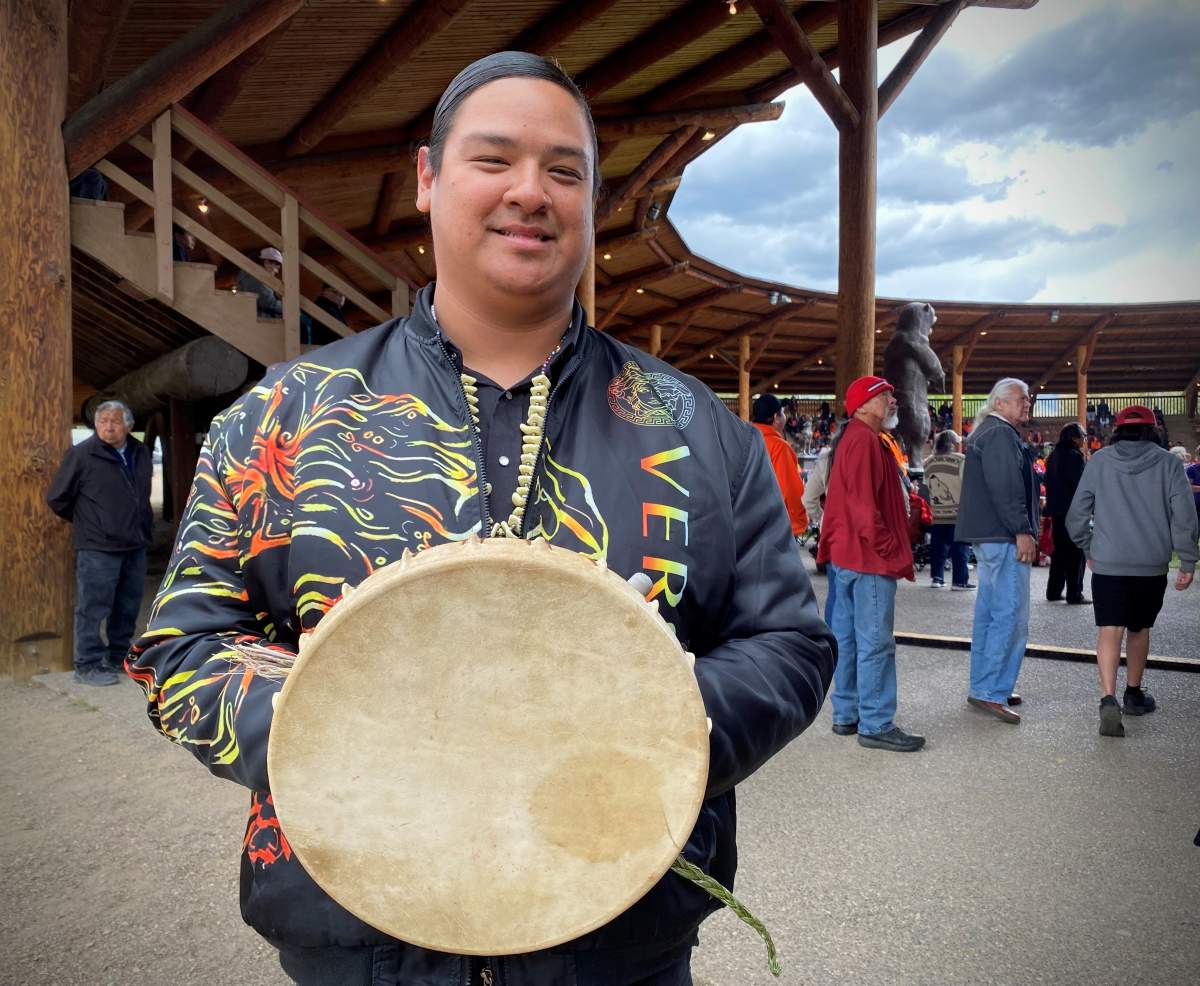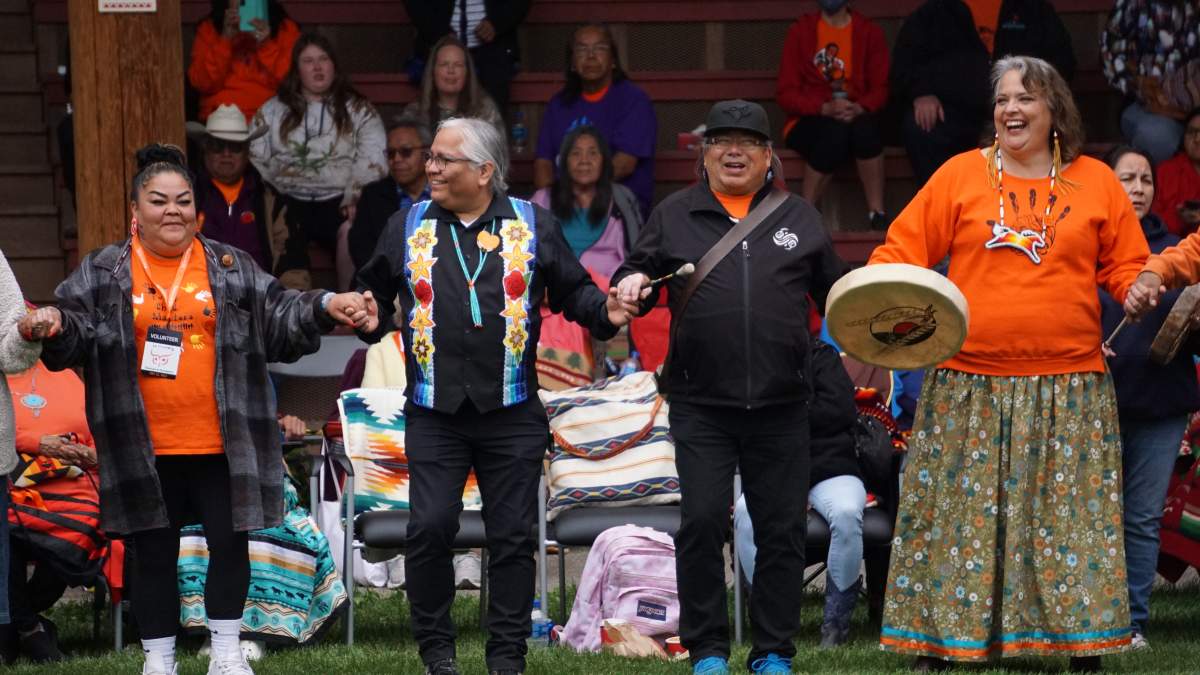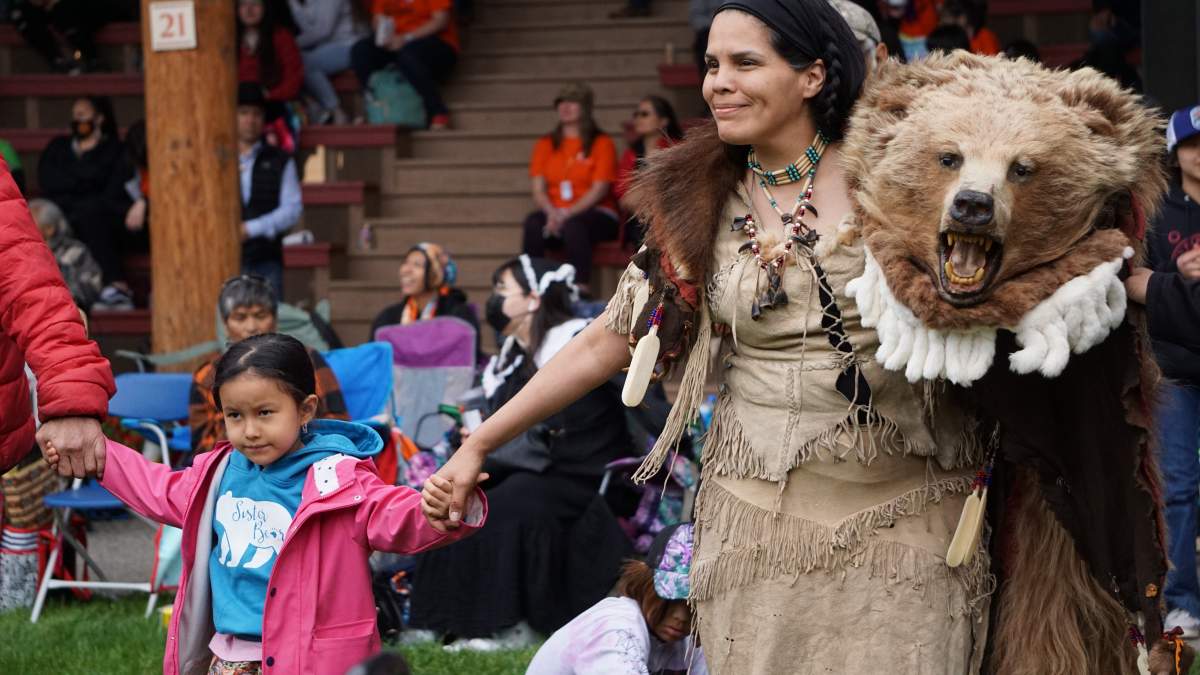Dustin Dion Stikwey Jules didn’t really plan on performing when he travelled to Tk’emlúps te Secwépemc on Monday.

The Skeetchestn Indian Band member has been a singer all his life, but called it a “spur of the moment” decision to walk up to the microphone in the Powwow Arbour and sing in the Secwepemctsin language.
“Whenever we share a time like this, we take it upon ourselves to share our culture and our beliefs with the people because it’s something that’s been passed down from generation to generation,” he said.
With braided sweetgrass and his son’s drum in his hands, he shared a Lahal song. It’s traditionally performed during tournaments, but Jules said it has helped his community in times of need, and could do the same for those attending the one-year memorial for Le Estcwicwéy̓.
“It’s about bringing people together, uplifting their spirits, giving them that good feeling, that choice of comfort,” he told Global News.
As he sang, he said he thought of his mother, grandmother, aunts and uncles who survived the Kamloops Indian Residential School.
From the Honour Song to the jingle dress dance, music and movement played a central role in the ceremony honouring the 215 missing children, whose remains are believed to be buried by the former Kamloops Indian Residential School. The event included many speeches and prayers, but at the end of the day, Kúkpi7 Rosanne Casimir gave a special shoutout to the drummers, dancers and singers.
“I can’t say enough as to how meaningful it was that we had so many of our cultural singers and dancers today. That was our resilience,” she told the crowd, standing next to Prime Minister Justin Trudeau.

Get breaking National news
“Let’s be proud of who we are. We need our children to be proud of who we are.”

Careful thought went into choosing the songs performed at the Le Estcwicwéy̓ memorial, several singers told Global News. According to Iye’mitun Slahhwwaletze Sewedit, a visiting cultural support worker from Snuneymuxw First Nation on Vancouver Island, it’s all based on the type of occasion.
He chose his grandmother’s Prayer Song, written by his granduncle about her calls to all the people in the Cowichan Valley to join her in prayer.
“I sang it at gatherings like this one here because we’re coming together to be as one … coming together as one heart, one mind, one spirit,” Sewedit said outside the Powwow Arbour.
“It took a lot for me not to break down and cry because I get emotional easy. It felt good to sing that, especially for everybody that’s here in residential school because I know what they’ve been through.”
The 10-hour event included both spontaneous songs and dances, and planned performances in at least half a dozen Indigenous languages, such as Secwepemctsin, Cree, Hul’q’umin’um, and Sḵwx̱wú7mesh.
The Redrum Motorcycle Club, which includes survivors and intergenerational survivors of residential schools, sang ‘Happy Birthday’ for Le Estcwicwéy̓, whose lives were cut short. The Paul Creek Singers and Dancers led the crowd in the Celebration and Friendship Song.
“The Celebration Dance is done in honour of life and in honour of those passing onto the spirit world,” explained Elder Charlotte Manuel, thanking her elders for passing on their knowledge.
The dancers moved together in a circle with open hands turned upward toward the sky. Manuel, a survivor of Kamloops Indian Residential School, danced joyfully from her seat.
After she danced, Jackie Andrew of Lil’wat Nation said she feels “grounded and lifted.” A St’át’imc bear dancer and a twin, she told Global News she carried the “very sacred” animal spirit to the memorial in Tk’emlúps te Secwépemc.
“This is what we call ancestral work. We’re here to be of good service to our ancestors, because we wouldn’t be here today if they didn’t survive and pass down their oral traditions,” she explained, wearing her grizzly regalia.
“This is the medicine that heals us, that helps us prosper as a people.”
Jackie said attended the memorial with her family and danced to support survivors, including her parents and grandparents, who attended Kamloops Indian Residential School and St. Mary’s Indian Residential School in Mission, B.C.
“It’s all about intention. If you have good intention your prayers will be answered,” she said.
- Surrey police say home possibly targeted in 3 separate shootings
- Some B.C. highways in North Coast reopen after closures due to flooding
- B.C. paramedics union warns of potential job action as bargaining talks break down
- ‘He hunted them’: Family launches petition to keep B.C. mass murderer behind bars












Comments